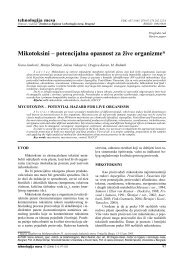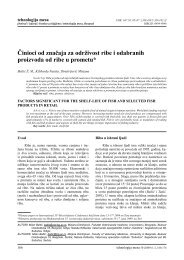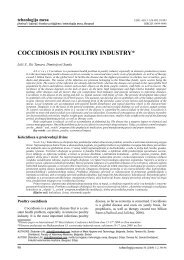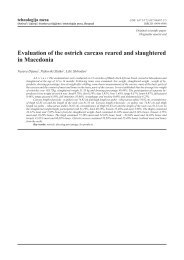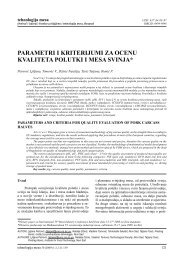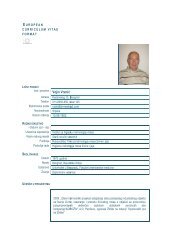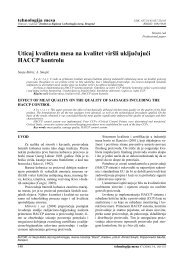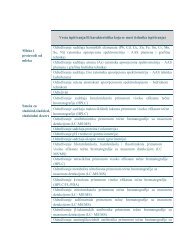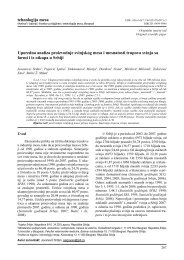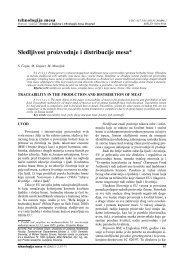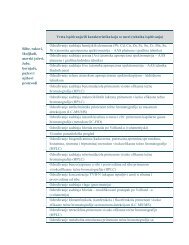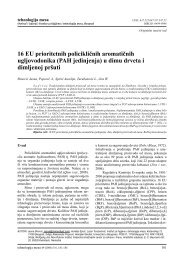Najnoviji broj Äasopisa - inmesbgd.com
Najnoviji broj Äasopisa - inmesbgd.com
Najnoviji broj Äasopisa - inmesbgd.com
You also want an ePaper? Increase the reach of your titles
YUMPU automatically turns print PDFs into web optimized ePapers that Google loves.
Vesković-Moračanin Slavica<br />
Uticaj faktora sredine na intenzitet antimikrobne aktivnosti bakteriocina<br />
Drosinos E. H., Mataragas M., Vesković-Moračanin S., Gasparik-Reichardt<br />
J., Hadziosmanović M., Alagić D.,<br />
2006. Quantifying nonthermal inactivation of Listeria<br />
monocytogenes in European fermented sausages using<br />
bacteriocinogenic lactic acid bacteria or their bacteriocins:<br />
A case study for risk assessment. Journal of Food Protection,<br />
69, 2648–2663.<br />
El-Ziney M. G., Debevere J., Jakobsen M., 2000. Reuterin. In:<br />
Naidu, A.S. (Ed.), Natural Food Antimicrobial Systems.<br />
CRC Press, London, 567–587.<br />
Gálvez A., Abriouel H., López R. L., Omarn B., 2007. Bacteriocin-based<br />
strategies for food biopreservation. International<br />
Journal of Food Microbiology, 120, 51–70.<br />
Gross E., Morell J. L., 1971. The structure of nisin. Journal of<br />
the American Chemical Society, 93, 4634-4645.<br />
Guerra N. P., Macias C. L., Agrasar A. T., Castro L. P., 2005.<br />
Development of a bioactive packaging cellophane using<br />
Nisaplin as biopreservative agent. Letters in Applied Microbiology,<br />
40, 106–1610.<br />
Hartnett D. J., Vaughan A., van Sinderen D., 2002. Antimicrobial-Producing<br />
Lactic Acid Bacteria Isolated from<br />
Raw Barley and Sorghum. Journal of the Institute of<br />
Brewing, 108, 2, 169–177.<br />
Hastings J. W., Sailer M., Johnson K. Roy K. L., Veders J.<br />
C., Stiles M. E., 1991. Characterization of leucocin A-<br />
UAL 187 and cloning of the bactericin gene from Leuconostoc<br />
gelidum. Journal of Bacteriology,173, 23, 7491–<br />
7500.<br />
Helander I. M., von Wright A., Mattila-Sandholm T. M.,<br />
1997. Potential fo lactic acid bacteria and novel antimicrobials<br />
against Gram-negative bacteria. Trends in Food<br />
Science & Technology, 8, 5, 146–50.<br />
Heng N. C. K., Tagg J. R ., 2006. What is in a name? Class distinction<br />
for bacteriocins. Nature Reviews Microbiology,<br />
4. doi:10.1038/nrmicro1273-c1., Correspondence (February<br />
2006).<br />
Henning S., Metz R., Hammes W. P., 1986. New aspects for<br />
the application of nisin to food products based on its mode<br />
of action. International Journal of Food Microbiology, 3,<br />
135–141.<br />
Holzapfel W. H., Geisen R., Schillinger U., 1995. Biological<br />
preservation of foods with reference to protective cultures,<br />
bacteriocins and food-grade enzymes. International<br />
Journal of Food Microbiology, 24, 343–362.<br />
Holzapfel W. H., 2002. Appropriate starter culture technologies<br />
for small-scale fermentation in developing countries. International<br />
Journal of Food Microbiology, 75, 197–212.<br />
Hurst A., 1981. Nisin. Advances in Applied Microbiology, 27,<br />
85–123.<br />
Klaenhammer T. R., 1993. Genetics of bacteriocins produced<br />
by lactic acid bacteria. FEMS Microbiology Reviews, 12,<br />
39–86.<br />
Kozačinski L., Drosinos E. H., Caklovica F, Cocolin L., Gasparik-Reichardt<br />
J., Vesković S., 2008. Investigation of<br />
microbial association of traditionally fermented sausages.<br />
Food Technology and Biotechnology, 46, 93–106.<br />
Kumar C. G., Anand S. K., 1998. Significance of microbial biofilms<br />
in food industry: a review. International Journal of<br />
Food Microbiology, 42, 9–27.<br />
Leroy F., De Vuyst L. 1999. Temperature and pH conditions that<br />
prevail durign the fermentation of sausages are optimal for<br />
the production of the antilisterial bacteriocin sakacin K.<br />
Applied and Environmental Microbiology, 65, 974–981.<br />
Lucke F. K., 1985. Fermented sausages. In: B. J. Wood (Ed).<br />
Microbiology of Fermented Foods.Vol 2, Elsevier Applied<br />
Science Publisher, London, 41–83.<br />
Magnusson J., Schnürer J., 2001. Lactobacillus coryniformis<br />
subsp. coryniformis strain Si3 produces a broad-spectrum<br />
proteinaceous antifungal <strong>com</strong>pound. Applied and Environmental<br />
Microbiology, 67, 1–5.<br />
Martínez B., Bravo D., Rodriguez A., 2005. Consequences<br />
of the development of nisin-resistant Listeria monocytogenes<br />
in fermented dairy products. Journal of Food Protection,<br />
68, 2383–2388.<br />
Mauriello G., Ercolini D., La Storia A., Casaburi A.,Villani<br />
F., 2004. Development of polyethylene films for food<br />
packaging activated with an antilisterial bacteriocin from<br />
Lactobacillus curvatus 32Y. Journal of Applied Microbiology,<br />
97, 314–322.<br />
Mauriello G., De Luca E., La Storia A., Villani F., Ercolini<br />
D., 2005. Antimicrobial activity of a nisin-activated plastic<br />
film for food packaging. Letters in Applied Microbiology,<br />
41, 464–469.<br />
Morris S. L., Walsh R. C., Hansen J. N., 1984. Identification<br />
and characterization of some bacterial membrane sulfhydryl<br />
groups which are targets of bacteriostatic and antibiotic<br />
action. Journal of Biological Chemistry, 201, 581–<br />
584.<br />
Mortvedt C. I., Nissen-Meyer J., Sletten K., Nes I. F., 1991.<br />
Purification and amino acid sequence of lactocin S, a bacteriocin<br />
produced by Lactobacillus sake L45. Applied and<br />
Environmental Microbiology, 57, 1829–34.<br />
Obradović D., Vesković-Moračanin S., 2007. Funkcionalne<br />
fermentisane kobasice – sadašnje stanje i persepktive.<br />
Tehnologija mesa, 48, 93–97.<br />
Parente E., Riccardi A., 1994. Influence of pH on the production<br />
of enterocin 1146 during batch fermentation. Letters<br />
in Applied Microbiology, 19, 12–15.<br />
Prajapati J. B., Nair B. M., 2003. The history of fermented<br />
foods. In: Farnworth, E.R. (Ed.), Fermented Functional<br />
Foods. CRC Press, Boca Raton, New York, London,<br />
Washington DC, 1–25.<br />
Rodríguez J. M., Martinez M. I., Horn N., Dodd H. M., 2003.<br />
Heterologous production of bacteriocins by lactic acid<br />
bacteria. International Journal of Food Microbiology, 80,<br />
101–116.<br />
Rogers L. A., 1928. The inhibiting effect of Streptococcus lactis<br />
on Lactobacillus bulgaricus. Journal of Bacteriology,<br />
16, 321–325.<br />
Rogers L. A., Whittier E. D., 1928. Limiting factors in lactic<br />
fermentation. Journal of Bacteriology, 16, 211–229.<br />
Ross A. I. V., Griffiths M. W., Mittal G. S., Deeth H. C., 2003.<br />
Combining nonthermal technologies to control foodborne<br />
microorganisms. International Journal of Food Microbiology,<br />
89, 125–138.<br />
Ross R. P., Morgan S., Hill C., 2002. Preservation and fermentation:<br />
past,present and future. International Journal of<br />
Food Microbiology, 79, 3–16.<br />
Schillinger U., Geisen R., Holzapfel W. H., 1996. Potential of<br />
antagonistic microorganisms and bacteriocins for the biological<br />
preservation of foods. Trends in Food Science &<br />
Technology, 7, 158–164.<br />
Stevens K. A., Sheldon B. W., Klapes N. A., Klaenhammer T.<br />
R., 1991. Nisin treatment for the inactivation of Salmonella<br />
species and other Gram-negative bacteria. Applied<br />
and Environmental Microbiology, 67, 3613–3615.<br />
164



